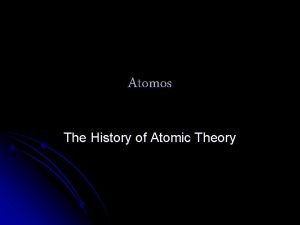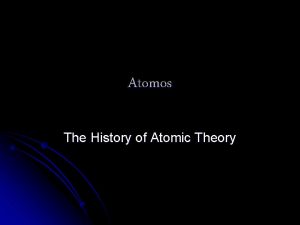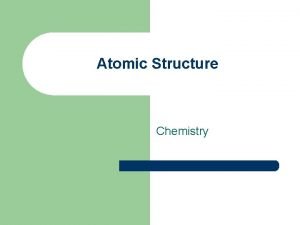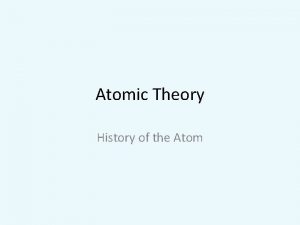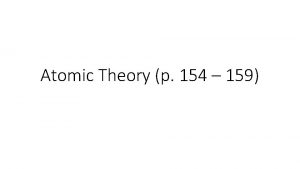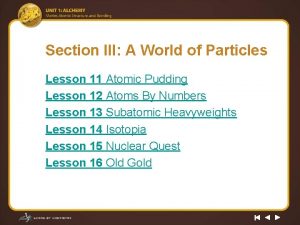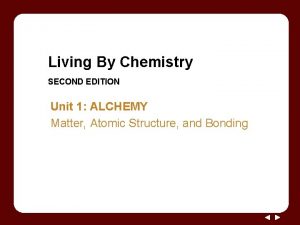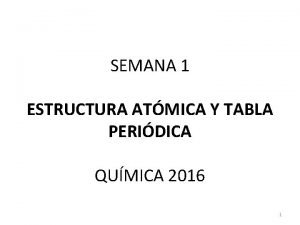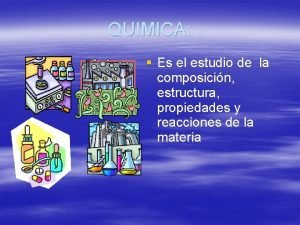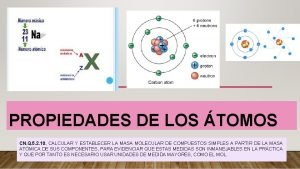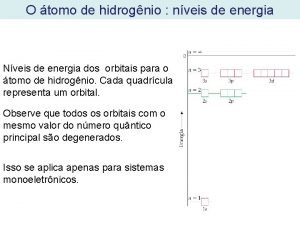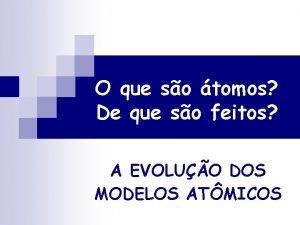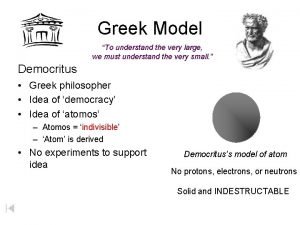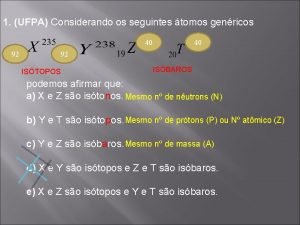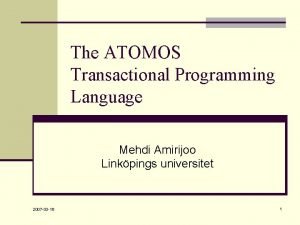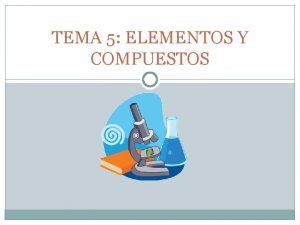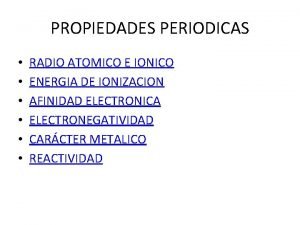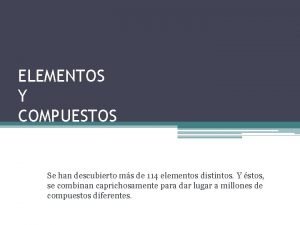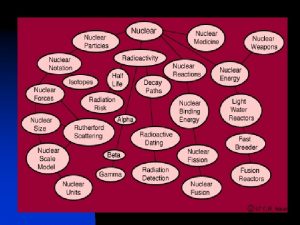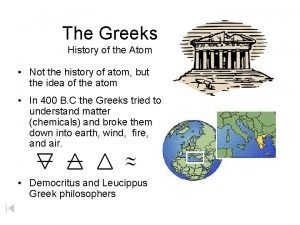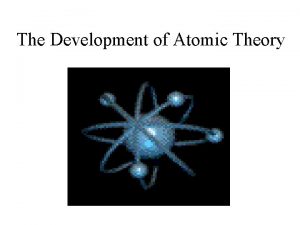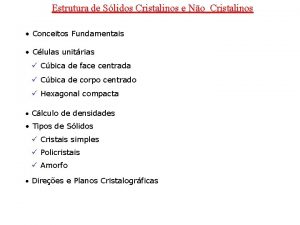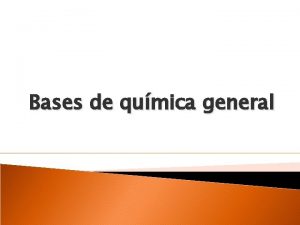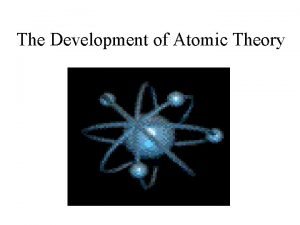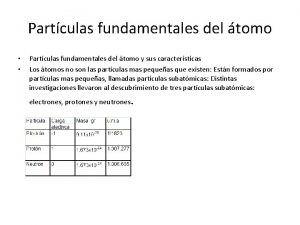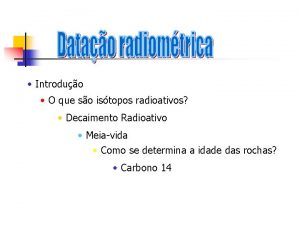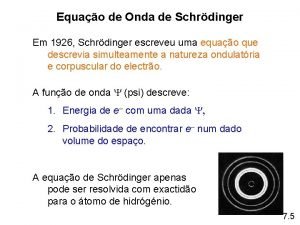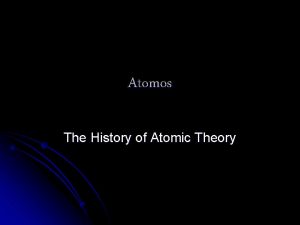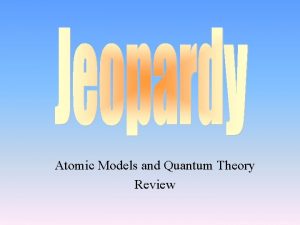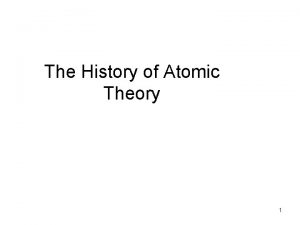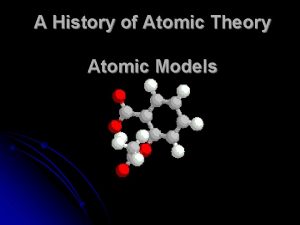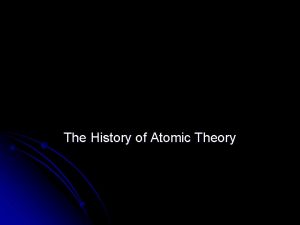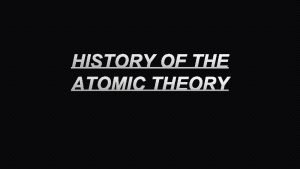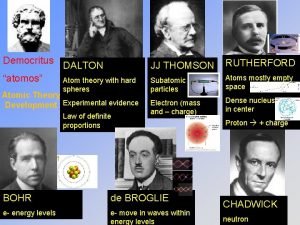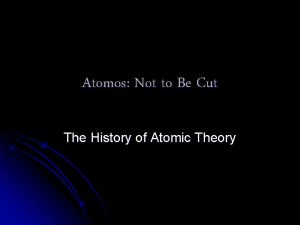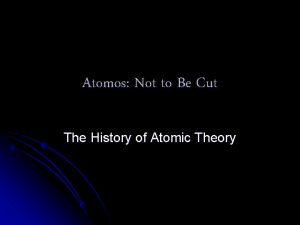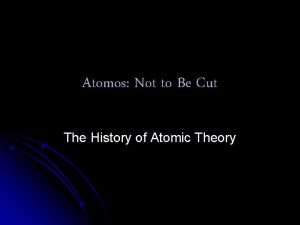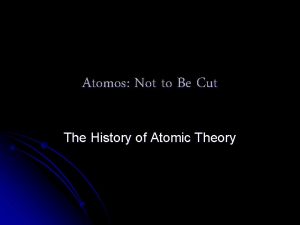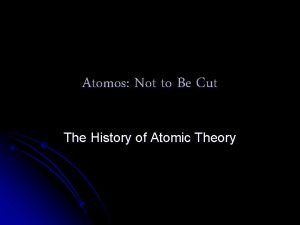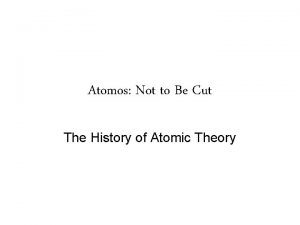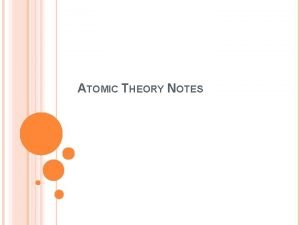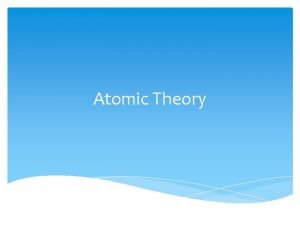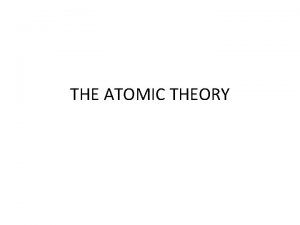Atomos The History of Atomic Theory Atomic Models






































- Slides: 38

Atomos The History of Atomic Theory

Atomic Models This is the Bohr model. In this model, the nucleus is orbited by electrons, which are in different energy levels. A model uses ideas to explain facts A model can be changed as new information is collected.

l The atomic model has changed throughout the centuries, starting in 400 BC, when it looked like a billiard ball →

Who are these men? In this lesson, we’ll learn about the men whose quests for knowledge about the fundamental nature of the universe helped define our views.

Democritus began the search for a description of matter more than 2400 years ago. He asked: Could matter be divided into smaller and smaller pieces forever, or was there a limit to the number of times a piece of matter could be divided? 400 BC

Atomos His theory: Matter could not be divided into smaller and smaller pieces forever, eventually the smallest possible piece would be obtained. l This piece would be indivisible. l He named the smallest piece of matter “atomos, ” meaning “not to be cut. ”

§ § To Democritus, atoms were small, hard particles that were all made of the same material but were different shapes and sizes. Atoms were infinite in number, always moving and capable of joining together.

This theory was ignored and forgotten for more than 2000 years!

The eminent Why? philosophers of the time, Aristotle and Plato, had a more respected, (and ultimately wrong) theory. Aristotle and Plato favored the earth, fire, air and water approach to the nature of matter. Their ideas held sway because of their eminence as philosophers. The atomos idea was buried for approximately 2000 years.

Dalton’s Model In the early 1800 s, the English Chemist John Dalton performed a number of experiments that eventually led to the acceptance of the idea of atoms.

Dalton’s Theory l l He deduced that all elements are composed of atoms. Atoms are indivisible and indestructible particles. Atoms of the same element are exactly alike. Atoms of different elements are different. Compounds are formed by the joining of atoms of two or more elements.

This theory became one of the. foundations of modern chemistry.

Thomson’s Plum Pudding Model In 1897, the English scientist J. J. Thomson provided the first hint that an atom is made of even smaller particles.

l l He proposed a model of the atom that is sometimes called the “Plum Pudding” model. Atoms were made from a positively charged substance with negatively charged electrons scattered about, like raisins in a pudding.

Thomson studied the passage of an electric current through a gas. l As the current passed through the gas, it gave off rays of negatively charged particles. l

Where did they come from? l This surprised Thomson, because the atoms of the gas were uncharged.

Thomson concluded that the negative charges came from within the atom. l A particle smaller than an atom had to exist. l The atom was divisible! l Thomson called the negatively charged “corpuscles, ” today known as electrons. l Since the gas was known to be neutral, having no charge, he reasoned that there must be positively charged particles in the atom. l But he could never find them.

Rutherford’s Gold Foil Experiment l In 1908, the English physicist Ernest Rutherford was hard at work on an experiment that seemed to have little to do with unraveling the mysteries of the atomic structure.

l Rutherford’s experiment Involved firing a stream of tiny positively charged particles at a thin sheet of gold foil (2000 atoms thick)

l Most of the positively charged “bullets” passed right through the gold atoms in the sheet of gold foil without changing course at all. l Some of the positively charged “bullets, ” however, did bounce away from the gold sheet as if they had hit something solid. He knew that positive charges repel positive


l This could only mean that the gold atoms in the sheet were mostly open space. Atoms were not a pudding filled with a positively charged material. l Rutherford concluded that an atom had a small, dense, positively charged center that repelled his positively charged “bullets. ” l He called the center of the atom the “nucleus” l The nucleus is tiny compared to the atom as a whole.

l Rutherford reasoned that all of an atom’s positively charged particles were contained in the nucleus. The negatively charged particles were scattered outside the nucleus around the atom’s edge.

Bohr Model In 1913, the Danish scientist Niels Bohr proposed an improvement. In his model, he placed each electron in a specific energy level.

According to Bohr’s atomic model, electrons move in definite orbits around the nucleus, much like planets circle the sun. These orbits, or energy levels, are located at certain distances from the nucleus.

Wave Model

l Today’s atomic model is based on the principles of wave mechanics. l According to theory of wave mechanics, electrons do not move about an atom in a definite path, like the planets around the sun.

l In fact, it is impossible to determine the exact location of an electron. The probable location of an electron is based on how much energy the electron has. l According to the modern atomic model, at atom has a small positively charged nucleus surrounded by a large region in which there are enough electrons to make an atom neutral.

Electron Cloud: l A space in which electrons are likely to be found. l Electrons whirl about the nucleus billions of times in one second l They are not moving around in random patterns. l Location of electrons depends upon how much energy the electron has.

Indivisible Electron Greek X Dalton X Nucleus Thomson X Rutherford X X Bohr X X Wave X X Orbit Electron Cloud X X


What forces hold the atom together? Electromagnetic likes repel, opposites attract (+ or -) Weak Force works with quarks and leptons and decides how flavors change helps stabilize nuclei through beta decay shorter distances than the strong force! Strong Force interacts with hadrons or nucleons so the protons and neutrons binds them together works only at distances smaller than 1 quadrillionth of a meter!!! Gravity Since this binds matter together based on mass, we think this plays no role in atoms

So subatomic particles are themselves made of smaller particles! l Subatomic particles composed of fast moving points of energy called quarks Quark Calculations (for protons and neutrons) Each proton is 2 up quarks and 1 down quark 2(2/3) – 1(1/3) = 4/3 – 1/3 = 3/3 or +1 Each neutron is 2 down quarks and 1 up quark 2(-1/3) + 2/3 = 0 Each electron is composed of 2 down quarks 3(-1/3) = -1

What is a quark, anyway? fundamental particle which possesses electric charge and 'strong' charge. They combine in groups of two or three to form mesons and baryons The are held together by the strong force.

There are several kinds of quarks come in six different species (physicists call them 'flavors') each flavor has a unique mass.

So, are there other characteristics of quarks? The two lightest are 'up' and 'down' quarks They combine to form protons and neutrons. The heavier quarks aren't found in nature and have so far only been observed in particle accelerators.

How are new particles discovered? http: //www. youtube. com/watch? v=V 0 Kj. Xs GRvo. A

How do accelerators work?
 Atomos atomic model
Atomos atomic model Atomos model
Atomos model Atomos atomic model
Atomos atomic model History of atomic models
History of atomic models Atomic models timeline
Atomic models timeline History of the atom
History of the atom Modals and semi modals
Modals and semi modals Atomic models in order
Atomic models in order Lesson 11 atomic pudding models of the atom
Lesson 11 atomic pudding models of the atom Atomic alchemy
Atomic alchemy Numero de atomos como calcular
Numero de atomos como calcular Tabla de atomos neutros
Tabla de atomos neutros Neutrones protones y electrones del azufre
Neutrones protones y electrones del azufre Propiedades de los atomos
Propiedades de los atomos Polieletronico
Polieletronico Rutherford bohr atomo
Rutherford bohr atomo Ancient greek model of the atom
Ancient greek model of the atom Um cientista dispoe de 19 2g de atomos
Um cientista dispoe de 19 2g de atomos Atomos diatomicos
Atomos diatomicos Considerando os seguintes átomos genéricos
Considerando os seguintes átomos genéricos Atomos language
Atomos language Ejemplos de cristales
Ejemplos de cristales Clasificacion de compuesto inorganico
Clasificacion de compuesto inorganico Como se forma un cation
Como se forma un cation Ejemplos de atomos aislados
Ejemplos de atomos aislados Atom berasal dari kata atomos yang berarti
Atom berasal dari kata atomos yang berarti Greek atom
Greek atom What does atomos mean
What does atomos mean Dalton 1808
Dalton 1808 Qumica
Qumica Pontos atomos
Pontos atomos Saturada
Saturada Professor agamenon roberto
Professor agamenon roberto What does the greek word atomos mean
What does the greek word atomos mean Transitria
Transitria Las partículas fundamentales del átomo son
Las partículas fundamentales del átomo son Os atomos sao formados por protons neutrons e eletrons
Os atomos sao formados por protons neutrons e eletrons Equação de onda de schrodinger
Equação de onda de schrodinger Sistemas de atomos
Sistemas de atomos
